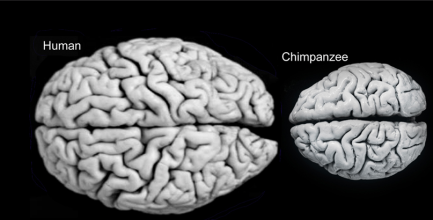Humans have absurdly large brains. It takes almost 1/5 of our daily calories1 (the equivalent of a big mac) just to keep it running; but the benefits of having such a large brain are fairly obvious. They’re the reason we got to be so successful. But faced with these side-effects, it’s certainly puzzling how we managed to evolve them in the first place, particularly given every other species ever seems to get by just fine without them.

A human and chimp brain. As you can see, when I say ours are absurdly large, I mean it
One of my favorite explanations is that we can blame climate change for our intelligence (and then, millions of years later, we can blame our intelligence for climate change). Imagine a dry climate. Obviously you’d need a special set of strategies, tools and behaviours to survive. Similarily, in a wet environment you’d need another unique set of adaptations. But what if the climate kept changing, swinging between wet and dry? The group that could innovate and adapt rapidly would win out; and that’s what our big brains let us do. We’re successful because no matter what the planet throws at us, we have the brains to figure out how to survive. And sure enough, palaeoclimate data shows there was a period of extreme climate variability, around 1 – 2 million years ago when our brains started to get big2.
However, Dr Grove – one of the lead proponents of this theory – reckons that this can also explain parts of our geography as well as our biology3. You see, modern humans evolved in Africa around 195,000 years ago4 and began expanding out into the rest of the world around 100,000 years ago. Dr Grove reckoned that a period of climate change forced our ancestors to become more flexible, allowing them to begin this migration; explaining why we suddenly got our act together and left home after 95,000 years of living in our parents basement.

When and where we migrated, along with what species of human were already living there when we arrived
To investigate this he created a computer model for how much climate variation is needed to favour flexibility. He discovered that the key was not necessarily severe climate change but repeated climate change. A lot of small changes were more likely to result in flexible computer-animals than a couple of big changes. Having run this model a few times and identified the factors that result in the evolution of flexibility he looked for these factors in sediment cores from Lake Tana3.
These are layers of sediment deposited on the lake bed at a fairly regular basis, each containing some elements from the air present in the period they were deposited. These elements correlate with the climate (in this case the ratio of titanium and calcium reflects the amount of rain during the period). As such they’re a very neat weather log of the planet over the past few hundred thousand years. When applying his climate model to it, Dr Grove found that there was a period leading up to 100,000 years ago when rainfall fluctuated a lot; which would have forced our ancestors to develop more flexible behavior. This, you may, recall lines up nicely with around the time humans began leaving Africa3.

The element ratios from Lake Tana (correlating with levels of more/less rainfall) were incredibly variable leading up to the human migrations out of Africa (brown bands)
This vindicates Dr Grove’s predictions very nicely; strongly suggesting he’s right. It seems that the environment began fluctuating around 150,000 years ago; forcing our ancestors to develop more flexible strategies that allowed them to survive in any climate. And then they realised “hey, the rest of the world counts as ‘any climate'” so off they went; migrating throughout the rest of the world. And it seems pretty good that they did have this added flexibility because boy, did they encounter a lot of different things. From ice ages to Neanderthals, our flexibility was pushed to the limit.
It should be noted that this research was only looking at one aspect of the climate (rain) from one region, so a larger comparison should be done to fully confirm his findings; although the strength of this result suggests that any such investigation will still vindicate these results.
References
- Brady, S., Siegel, G., Albers, R. W., & Price, D. (Eds.). (2005). Basic neurochemistry: molecular, cellular and medical aspects. Academic Press.
- Grove, M. (2012). Orbital dynamics, environmental heterogeneity, and the evolution of the human brain. Intelligence, 40(5), 404-418.
- Grove, M. (2014). Palaeoclimates, plasticity, and the early dispersal of< i> Homo sapiens</i>. Quaternary International.
- Boyd and Silk (2012). How Humans Evolved.

